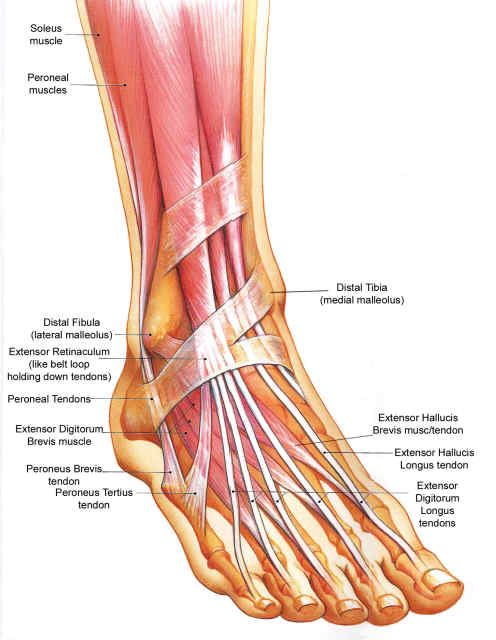The Ankle
Ankle Information

 The ankle is formed by the end of the shinbone and the outer leg bone over the talus. The subtalar joint in the ankle is formed by the underside of the talus and the top of the front part of the heel bone. The ankle is bound within a fibrous capsule which is lined by a fluid-producing synovial membrane. The capsule is supported and strengthened by ligaments on all sides. Muscles from the lower leg pass downward across the ankle and over the front and back are extensors and flexors and tendons. Where tendons lie close to the ankle, they are held in place by strong bands called retinacula which are protected from friction by tube-like sheaths filled with synovial fluid. The ankle has a rich supply of proprioceptive nerves, which are vital for your balance while standing and while in motion.
The ankle is formed by the end of the shinbone and the outer leg bone over the talus. The subtalar joint in the ankle is formed by the underside of the talus and the top of the front part of the heel bone. The ankle is bound within a fibrous capsule which is lined by a fluid-producing synovial membrane. The capsule is supported and strengthened by ligaments on all sides. Muscles from the lower leg pass downward across the ankle and over the front and back are extensors and flexors and tendons. Where tendons lie close to the ankle, they are held in place by strong bands called retinacula which are protected from friction by tube-like sheaths filled with synovial fluid. The ankle has a rich supply of proprioceptive nerves, which are vital for your balance while standing and while in motion.
Wear and tear damage in the ankle known as osteoarthritis often occurs from late middle age onwards, although it can happen to younger people. It is most often a long-term effect of previous injuries and/or too much strenuous weight-bearing exercise such as ultra-distance running.
The bones and soft tissues in the ankle can be damaged by trauma or overuse. Ankle injury always disrupts the proprioceptive balance mechanisms, has a direct effect on the foot and lower leg muscles disrupting the rest of the leg on the same side, and usually causes overload on the opposite side. For a traumatic bone fracture, you should always receive immediate medical treatment.
Damage to the soft tissues through a tear, partial tear or from being overstretched may or may not result in immediate pain. Pain and stiffness may settle in later. The amount of pain you feel does not necessarily reflect the degree of tissue damage. The ankle can feel unstable and may give way if weight is applied.
After recovery from an ankle injury, there is often a major loss of proprioception causing instability. You may also experience chronic swelling even after the injury is fully healed. The fluid pools under the effect of gravity. Gravitational swelling is usually painless, but it can affect the foot if left uncontrolled.
Physical therapy can help to strengthen the ankle and improve proprioception for balance through isometric, strengthening, and mobilizing exercises.
Call our office today at 603-627-6381 if you suffer from an old or new injury so we can help.
